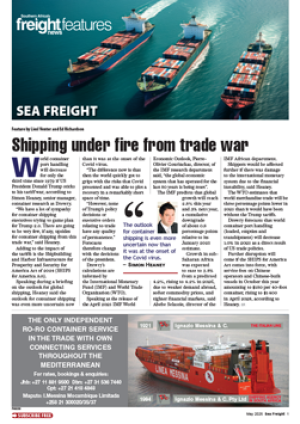The incidence of liquidations
in the freight industry appears
to be on a declining trend
when compared to the overall
development in company
closures across the entire
country, according to Luke
Doig, senior economist at the
Credit Guarantee Insurance
Corporation (CGIC).
“Logistics sector failures
accounted for 4.2% of total
bankruptcies last year,” he
told FTW. “This after having
picked up in 2011 and 2012
when the figures read 5.3%
and 5.9% respectively.”
However, Doig pointed
out, it is apparent that there
is a seasonal spike in the first
quarter of the year. Q1’14
saw 40 out of a total of 509
liquidations emanating from
the freight sector, or 7.9%
compared to the 8.4% seen in
Q1’13 (67 out of 801).
“One could argue that
the 36.5% fall in total
liquidations in Q1’14 (509
compared to 801 in Q1’13), as
well as the
declining
trend in total
closures
over the past
three years,
is somewhat
at odds
with the
overall state
of play in
the broader
economy,”
he added.
“Escalating input costs (fuel/
energy and labour); consumer
spend under pressure as
interest rates begin to
rise; low confidence levels
domestically; rising labour
tensions; and increased
regulatory intervention all
point to a difficult operating
environment.”
And, according to Doig, the
relatively new business rescue
provision
(introduced in
May 2011) has
served to skew
the official
liquidation
data
somewhat.
“So,” he
said, “the
improvement
noted in total
failures has to
be tempered.
“Furthermore, if one
considers that debt judgments
against businesses rose from
R1.075 billion in 2012 to
R1.14bn in 2012 and further
to R1.272bn in 2013, then one
gets a better feel for payment
defaults. In fact the average
value per judgment rose from
R23 584 in 2012 to R31 004
last year, a 31.5% rise.”
He argued that there had
been a notable number of
large corporate insolvencies
over the past 12 months that
had served to distort these
figures somewhat.
“Notwithstanding that,”
he added, “the business
environment has to date been
held hostage by the myriad
negative factors highlighted
above.
“If sentiment improves
and improved business
confidence can lead to higher
investment levels, then an
improved outlook may be in
the offing.”
But, what he described
as “the headwinds” for
consumers are unlikely to
abate soon and ongoing
labour strife poses another
threat.
“This latter point disrupts
the supply or productive side
of the economy, preventing
the freight industry from
taking advantage of
gradually improving global
demand.”
Doig then posed the
question: Can the new
government do anything to
alter this balance of opposing
forces so that the country
at large can grow at a much
faster pace than the current
moribund 2%?
His reply was short and
sharp. “We need it to.”
INSERT & CAPTION
If sentiment
improves, an
improved outlook
may be in the offing.
– Luke Doig

